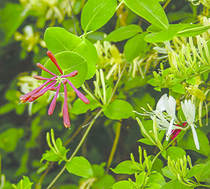 There are two types of honeysuckle vine in Forest Hill Park. One, the Japanese honeysuckle, is well known and loved by many. You may have never heard of the other. Here are their stories. The Japanese honeysuckle, Lonicera spp., was introduced to this country after European settlement as an ornamental and for wildlife value. For a while after introduction it lived wherever it was planted just as peonies, gardenias, and such plants live in our gardens today. And then, as seeds were transported by birds and other critters, this plant began to spread far and wide, covering and threatening shrubs, trees, anything in its path. Instead of being known for the sweet fragrance on a warm summer day or for the flowers’ taste of sweet nectar, it should be known as a very aggressive non-native species that is a threat to our environment. The other honeysuckle, Lonicera sempervirens, has been here for many thousands of years evolving with our native plants and animals. It belongs here. The beautiful, red flowers attract hummingbirds, bees, and butterflies; fruits are eaten by finches, the hermit thrush, robins and others. This plant is not an aggressive grower and, like many of our native plant species, is in danger of being lost to the non-native species that can easily out-compete with other plants. There are only a few of these left in Forest Hill Park.
This image, taken near the lake, shows both growing together; the native honey-suckle (with the red flower) is struggling to survive among the aggressive non-native plants. What can you do?
Comments are closed.
|
What's growing?This is where you can learn about the vast variety of plant and animal-life that makes Forest Hill Park its home. Archives
August 2017
Categories
All
|
 RSS Feed
RSS Feed